4-5 Practice Writing a Function Rule Answer Key
Lesson 1
Problem 1
Given the rule:
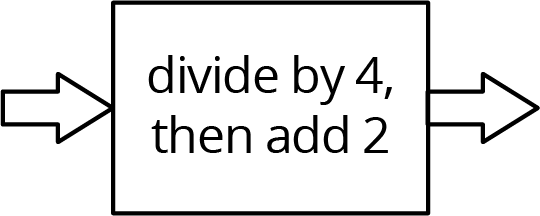 Complete the table for the function rule for the following input values:
Complete the table for the function rule for the following input values:
| input | 0 | 2 | 4 | 6 | 8 | 10 |
|---|---|---|---|---|---|---|
| output |
Problem 2
Here is an input-output rule:
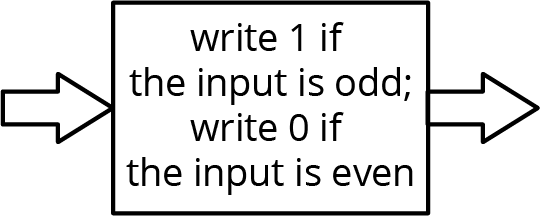 Complete the table for the input-output rule:
Complete the table for the input-output rule:
| input | -3 | -2 | -1 | 0 | 1 | 2 | 3 |
|---|---|---|---|---|---|---|---|
| output |
Problem 3 (from Unit 4, Lesson 15)
Andre's school orders some new supplies for the chemistry lab. The online store shows a pack of 10 test tubes costs \$4 less than a set of nested beakers. In order to fully equip the lab, the school orders 12 sets of beakers and 8 packs of test tubes.
- Write an equation that shows the cost of a pack of test tubes, $t$, in terms of the cost of a set of beakers, $b$.
- The school office receives a bill for the supplies in the amount of \$348. Write an equation with $t$ and $b$ that describes this situation.
- Since $t$ is in terms of $b$ from the first equation, this expression can be substituted into the second equation where $t$ appears. Write an equation that shows this substitution.
- Solve the equation for $b$.
- How much did the school pay for a set of beakers? For a pack of test tubes?
Problem 4 (from Unit 4, Lesson 14)
Solve: \(\begin{cases} y=x-4 \\ y=6x-10\\ \end{cases}\)
Problem 5 (from Unit 4, Lesson 9)
For what value of $x$ do the expressions $2x+3$ and $3x-6$ have the same value?
Lesson 2
Problem 1
Here are several function rules. Calculate the output for each rule when you use -6 as the input.

Problem 2
A group of students is timed while sprinting 100 meters. Each student's speed can be found by dividing 100 m by their time. Is each statement true or false? Explain your reasoning.
- Speed is a function of time.
- Time is a function of distance.
- Speed is a function of number of students racing.
- Time is a function of speed.
Problem 3 (from Unit 4, Lesson 15)
Diego's history teacher writes a test for the class with 26 questions. The test is worth 123 points and has two types of questions: multiple choice worth 3 points each, and essays worth 8 points each. How many essay questions are on the test? Explain or show your reasoning.
Problem 4
These tables correspond to inputs and outputs. Which of these input and output tables could represent a function rule, and which ones could not? Explain or show your reasoning.
Table A:
| input | output | |
|---|---|---|
| row 1 | -2 | 4 |
| row 2 | -1 | 1 |
| row 3 | 0 | 0 |
| row 4 | 1 | 1 |
| row 5 | 2 | 4 |
Table B:
| input | output | |
|---|---|---|
| row 1 | 4 | -2 |
| row 2 | 1 | -1 |
| row 3 | 0 | 0 |
| row 4 | 1 | 1 |
| row 5 | 4 | 2 |
Table C:
| input | output | |
|---|---|---|
| row 1 | 1 | 0 |
| row 2 | 2 | 0 |
| row 3 | 3 | 0 |
Table D:
| input | output | |
|---|---|---|
| row 1 | 0 | 1 |
| row 2 | 0 | 2 |
| row 3 | 0 | 3 |
Lesson 3
Problem 1
Here is an equation that represents a function: $72x+12y=60$.
Select all the different equations that describe the same function:
-
$120y + 720x = 600$
-
$y = 5 - 6x$
-
$2y + 12x = 10$
-
$y = 5 + 6x$
-
$x=\frac{5}{6} - \frac{y}{6}$
-
$7x + 2y = 6$
-
$x=\frac{5}{6} + \frac{y}{6}$
Problem 2 (from Unit 4, Lesson 13)
- Graph a system of linear equations with no solutions.
- Write an equation for each line you graph.
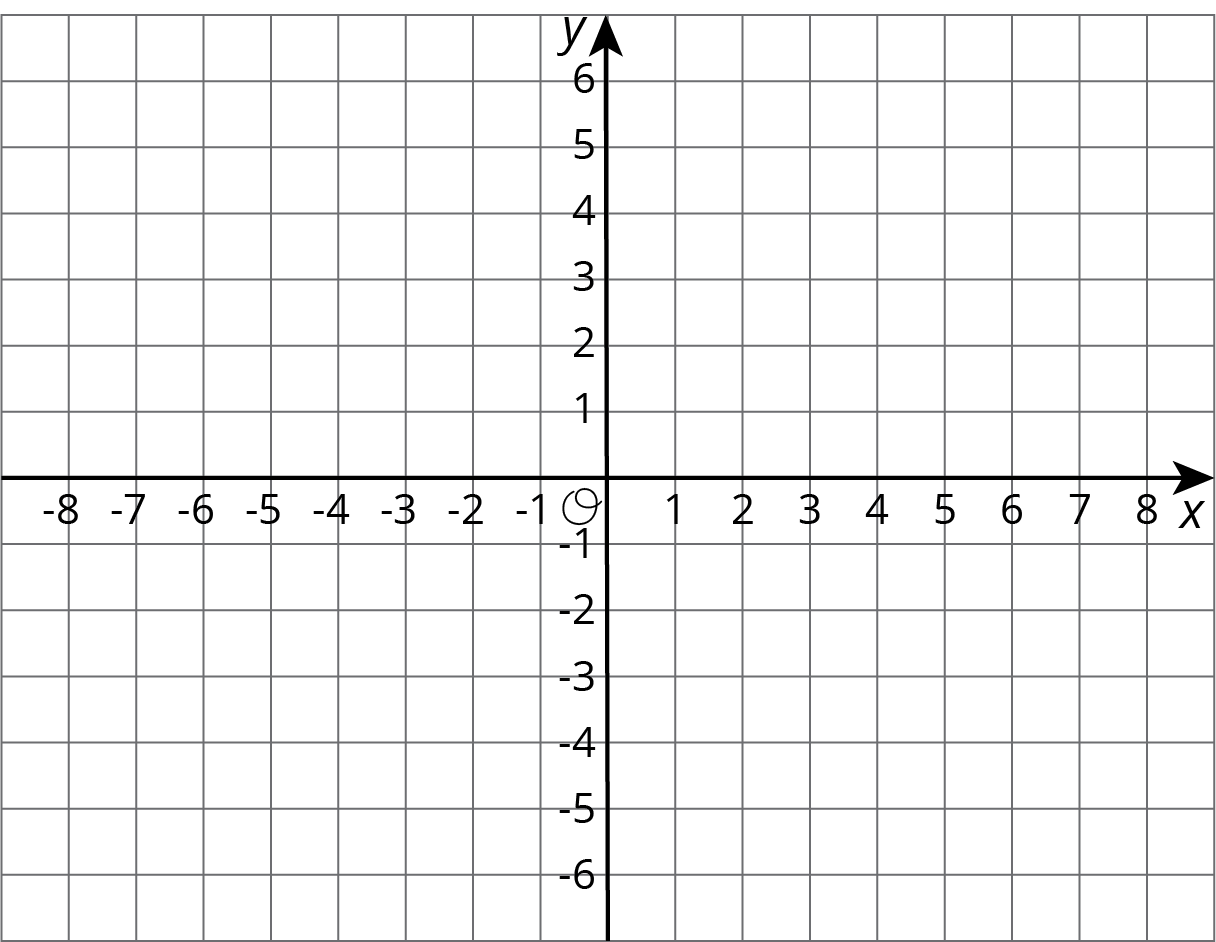
Problem 3
Brown rice costs \$2 per pound, and beans cost \$1.60 per pound. Lin has \$10 to spend on these items to make a large meal of beans and rice for a potluck dinner. Let $b$ be the number of pounds of beans Lin buys and $r$ be the number of pounds of rice she buys when she spends all her money on this meal.
- Write an equation relating the two variables.
- Rearrange the equation so $b$ is the independent variable.
- Rearrange the equation so $r$ is the independent variable.
Problem 4 (from Unit 4, Lesson 6)
Solve each equation and check your answer.
- \(2x+4(3-2x)=\frac{3(2x+2)}{6}+4\)
- \(4z+5=\text-3z-8\)
- \(\frac12-\frac18q=\frac{q-1}{4}\)
Lesson 4
Problem 1
The graph and the table show the high temperatures in a city over a 10-day period.
| day | 1 | 2 | 3 | 4 | 5 | 6 | 7 | 8 | 9 | 10 |
|---|---|---|---|---|---|---|---|---|---|---|
| temperature (degrees F) | 60 | 61 | 63 | 61 | 62 | 61 | 60 | 65 | 67 | 63 |
-
What was the high temperature on Day 7?
-
On which days was the high temperature 61 degrees?
-
Is the high temperature a function of the day? Explain how you know.
-
Is the day a function of the high temperature? Explain how you know.
Problem 2
The amount Lin's sister earns at her part-time job is proportional to the number of hours she works. She earns \$9.60 per hour.
-
Write an equation in the form $y=kx$ to describe this situation, where $x$ represents the hours she works and $y$ represents the dollars she earns.
-
Is $y$ a function of $x$? Explain how you know.
-
Write an equation describing $x$ as a function of $y$.
Problem 3
Use the equation $2m+4s=16$ to complete the table, then graph the line using $s$ as the dependent variable.
| $m$ | 0 | -2 | ||
|---|---|---|---|---|
| $s$ | 3 | 0 |
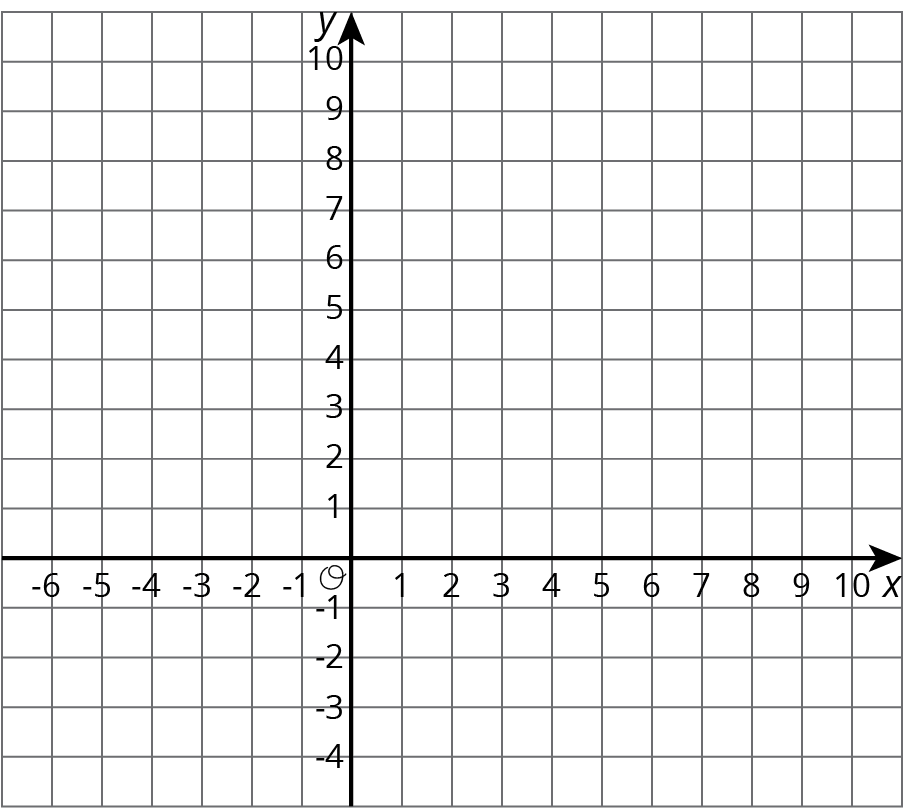
Problem 4 (from Unit 4, Lesson 13)
Solve the system of equations: \(\begin{cases} y=7x+10 \\ y=\text-4x-23 \\ \end{cases}\)
Lesson 5
Problem 1
Match each diagram to the function described, then label the axes appropriately
- The function inputs the age of an oak tree $a$ and outputs a prediction of the height of the tree $h$.
- The function inputs the edge length $e$ of a cube and outputs the volume $v$.
- The function inputs the distance traveled $d$ and predicts the amount of fuel left in the tank $f$.
- The function inputs the height $h$ of a triangle with base 12 and outputs the area $a$.
- The function inputs the time of day $t$ and predicts the temperature $T$.
- The function inputs the time of day $t$ and predicts the number of cars washed at a student car wash $c$.
Problem 2 (from Unit 4, Lesson 13)
The solution to a system of equations is $(6,\text-3)$. Choose two equations that might make up the system.
- $y=\text-3x+6$
- $y=2x-9$
- $y=\text-5x+27$
- $y=2x-15$
- $y=\text-4x+27$
Problem 3 (from Unit 5, Lesson 3)
A car is traveling on a small highway and is either going 55 miles per hour or 35 miles per hour, depending on the speed limits, until it reaches its destination 200 miles away. Letting $x$ represent the amount of time in hours that the car is going 55 miles per hour, and $y$ being the time in hours that the car is going 35 miles per hour, an equation describing the relationship is: $$55x + 35y = 200$$
- If the car spends 2.5 hours going 35 miles per hour on the trip, how long does it spend going 55 miles per hour?
- If the car spends 3 hours going 55 miles per hour on the trip, how long does it spend going 35 miles per hour?
- If the car spends no time going 35 miles per hour, how long would the trip take? Explain your reasoning.
Problem 4
The graph represents an object that is shot upwards from a tower and then falls to the ground. The independent variable is time in seconds and the dependent variable is the object's height above the ground in meters.
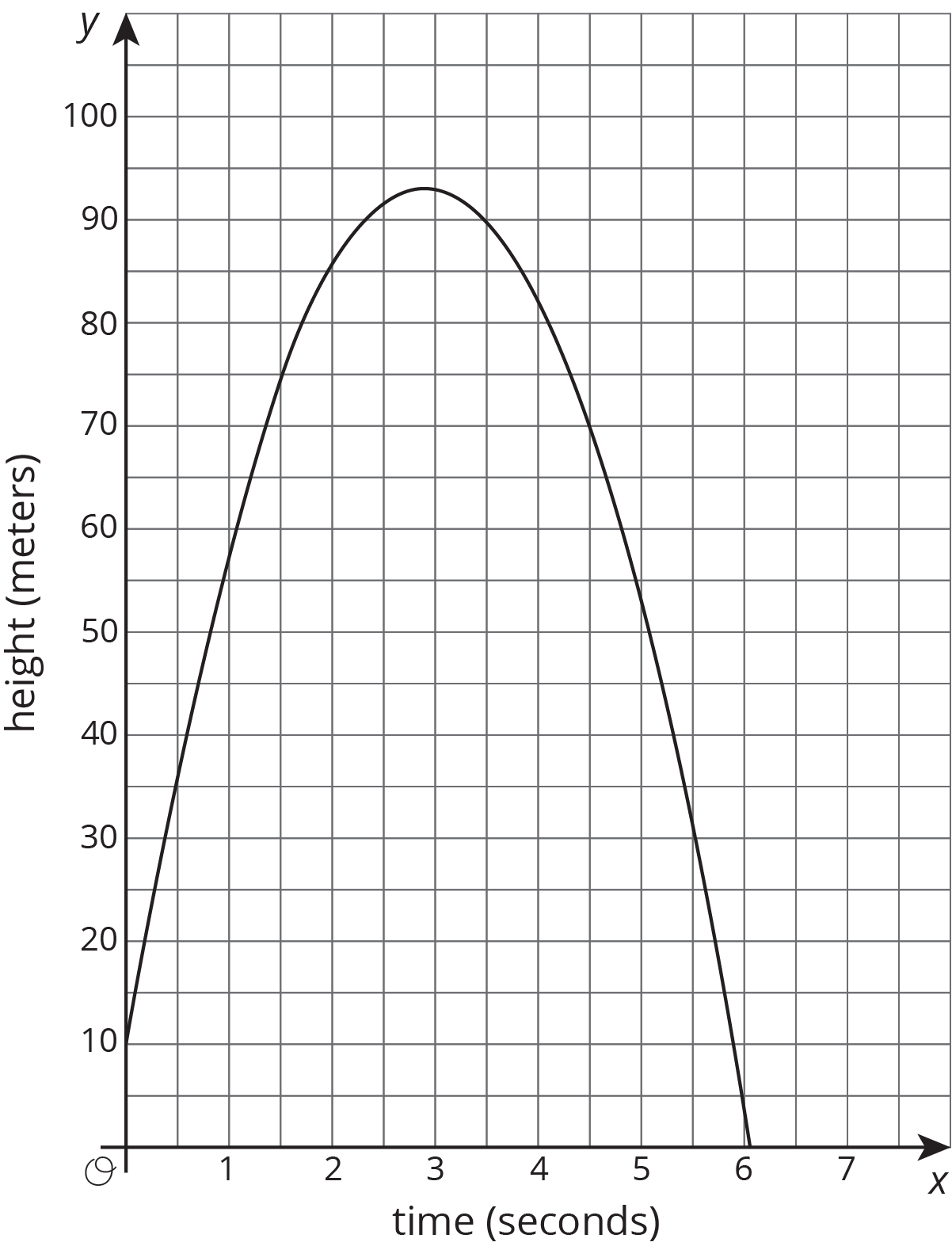
- How tall is the tower from which the object was shot?
- When did the object hit the ground?
- Estimate the greatest height the object reached and the time it took to reach that height. Indicate this situation on the graph.
Lesson 6
Problem 1
Match the graph to the following situations (you can use a graph multiple times). For each match, name possible independent and dependent variables and how you would label the axes.

- Tyler pours the same amount of milk from a bottle every morning.
- A plant grows the same amount every week.
- The day started very warm but then it got colder.
- A carnival has an entry fee of \$5 and tickets for rides cost \$1 each.
Problem 2
Jada fills her aquarium with water.
The graph shows the height of the water, in cm, in the aquarium as a function of time in minutes. Invent a story of how Jada fills the aquarium that fits the graph.
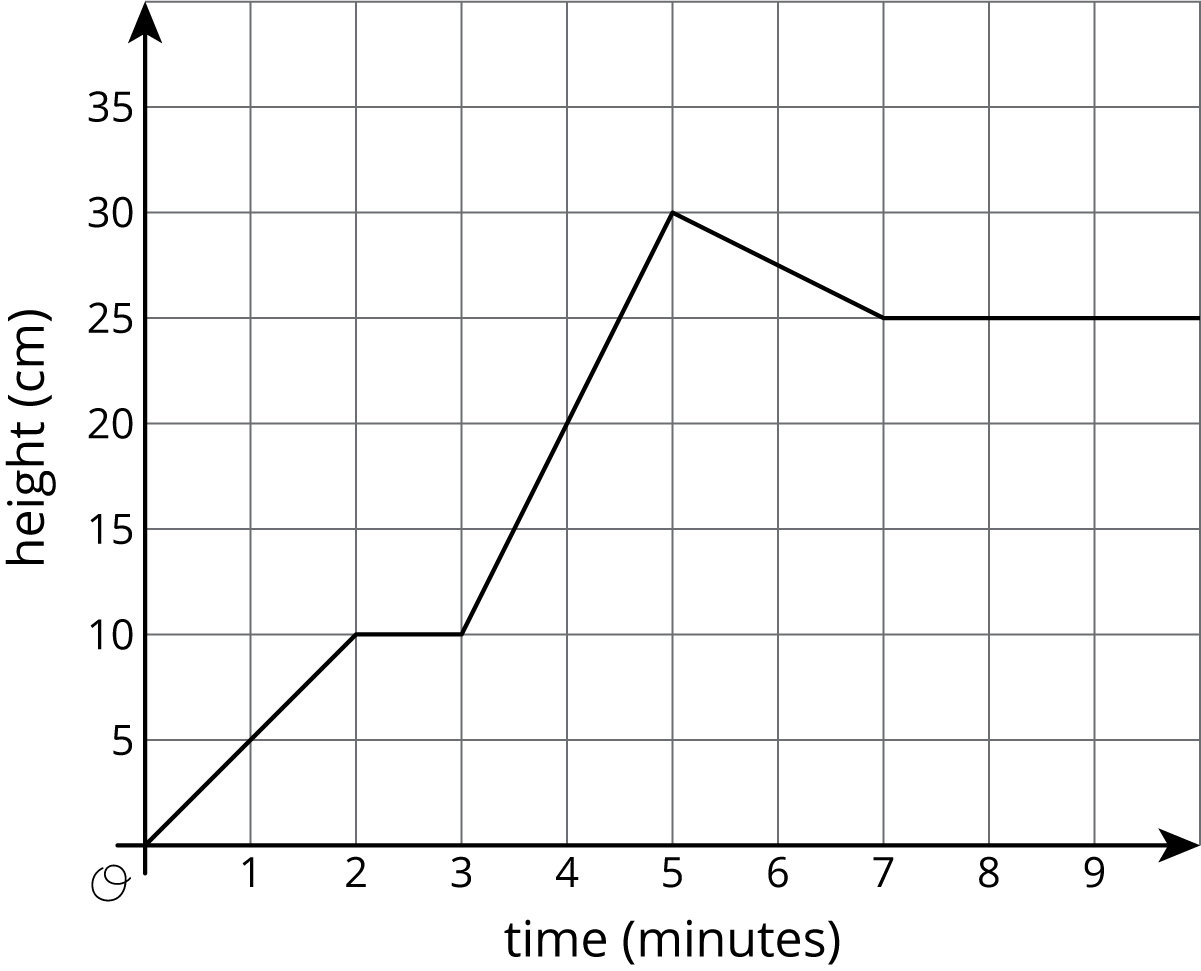
Problem 3 (from Unit 5, Lesson 4)
Recall the formula for area of a circle.
- Write an equation relating a circle's radius, $r$, and area, $A$.
- Is area a function of the radius? Is radius a function of the area?
- Fill in the missing parts of the table.
$r$ 3 $\frac12$ $A$ $16\pi$ $100\pi$
Problem 4 (from Unit 3, Lesson 11)
The points with coordinates $(4,8)$, $(2,10)$, and $(5,7)$ all lie on the line $2x+2y=24$.
- Create a graph, plot the points, and sketch the line.
- What is the slope of the line you graphed?
- What does this slope tell you about the relationship between lengths and widths of rectangles with perimeter 24?
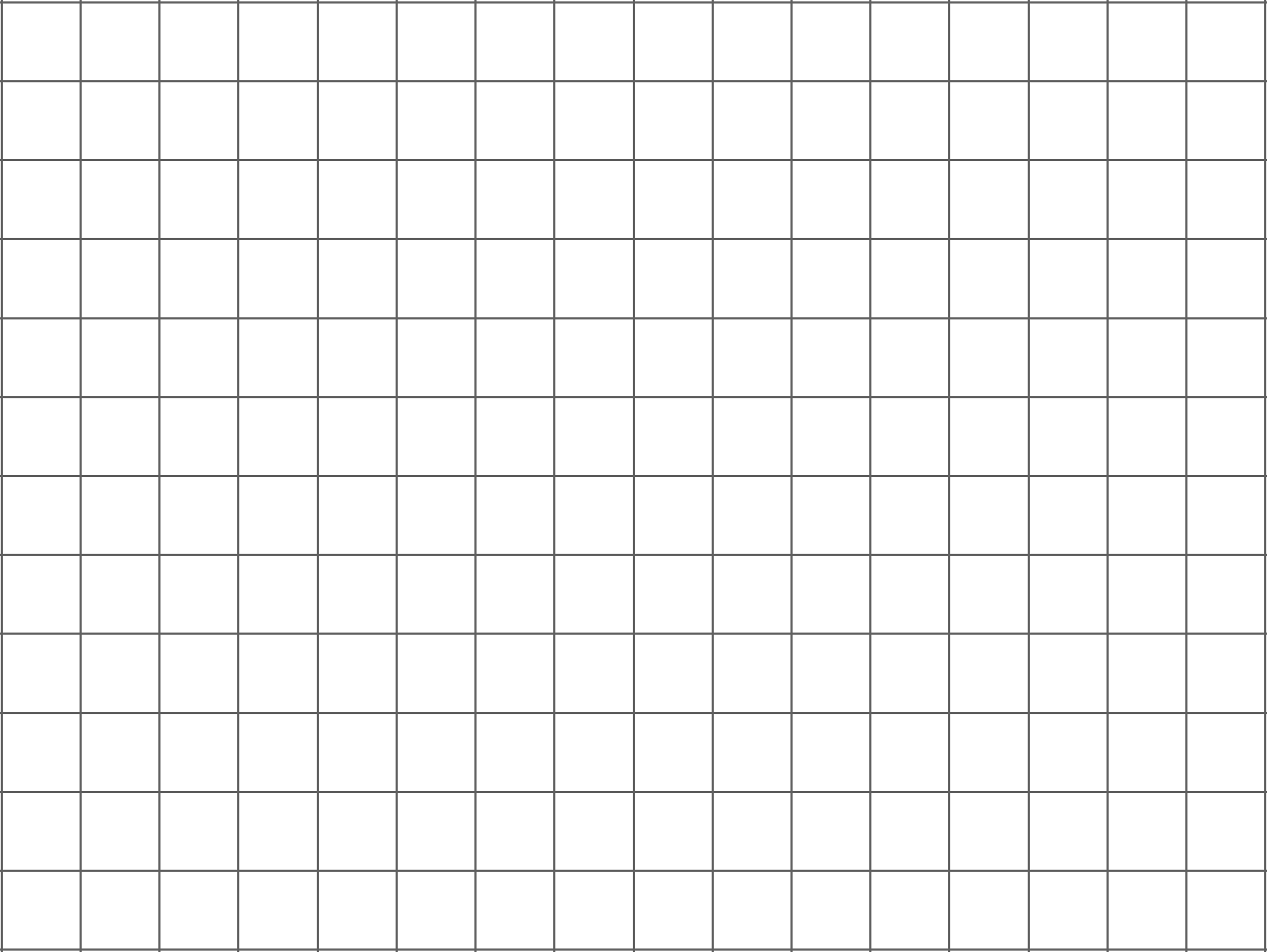
Lesson 7
Problem 1
The equation and the tables represent two different functions. Use the equation $b=4a-5$ and the table to answer the questions. This table represents $c$ as a function of $a$.
| $a$ | -3 | 0 | 2 | 5 | 10 | 12 |
|---|---|---|---|---|---|---|
| $c$ | -20 | 7 | 3 | 21 | 19 | 45 |
- When $a$ is -3, is $b$ or $c$ greater?
- When $c$ is 21, what is the value of $a$? What is the value of $b$ that goes with this value of $a$?
- When $a$ is 6, is $b$ or $c$ greater?
- For what values of $a$ do we know that $c$ is greater than $b$?
Problem 2 (from Unit 5, Lesson 2)
Match each function rule with the value that could not be a possible input for that function.
- 3 divided by the input
- Add 4 to the input, then divide this value into 3
- Subtract 3 from the input, then divide this value into 1
- 3
- 4
- -4
- 0
- 1
Problem 3
Elena and Lin are training for a race. Elena runs her mile a constant speed of 7.5 miles per hour.
Lin's times are recorded every minute:
| time (minutes) | 1 | 2 | 3 | 4 | 5 | 6 | 7 | 8 | 9 |
|---|---|---|---|---|---|---|---|---|---|
| distance (miles) | 0.11 | 0.21 | 0.32 | 0.41 | 0.53 | 0.62 | 0.73 | 0.85 | 1 |
-
Who finished their mile first?
-
This is a graph of Lin's progress. Draw a graph to represent Elena's mile on the same axes.
-
For these models, is distance a function of time? Is time a function of distance? Explain how you know.
Problem 4 (from Unit 4, Lesson 4)
Find a value of $x$ that makes the equation true: $$\text-(\text-2x+1)= 9-14x$$ Explain your reasoning, and check that your answer is correct.
Lesson 8
Problem 1
Two cars drive on the same highway in the same direction. The graphs show the distance, $d$, of each one as a function of time, $t$. Which car drives faster? Explain how you know.

Problem 2
Two car services offer to pick you up and take you to your destination. Service A charges 40 cents to pick you up and 30 cents for each mile of your trip. Service B charges \$1.10 to pick you up and charges $c$ cents for each mile of your trip.

- Match the services to the Lines $\ell$ and $m$.
- For Service B, is the additional charge per mile greater or less than 30 cents per mile of the trip? Explain your reasoning.
Problem 3
Kiran and Clare like to race each other home from school. They run at the same speed, but Kiran's house is slightly closer to school than Clare's house. On a graph, their distance from their homes in meters is a function of the time from when they begin the race in seconds.
- As you read the graphs left to right, would the lines go up or down?
- What is different about the lines representing Kiran's run and Clare's run?
- What is the same about the lines representing Kiran's run and Clare's run?
Problem 4 (from Unit 3, Lesson 11)
Write an equation for each line. 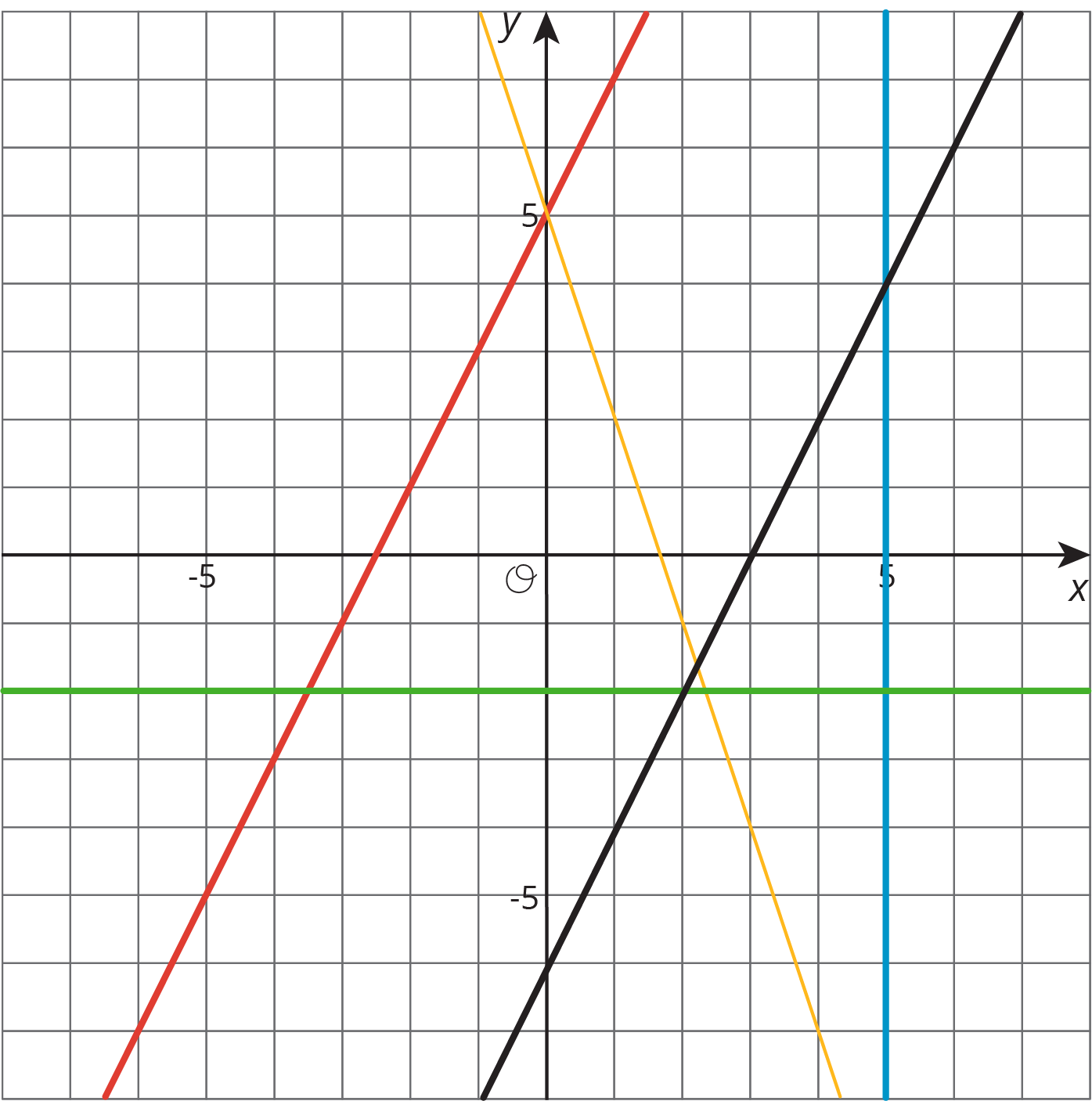
Lesson 9
Problem 1
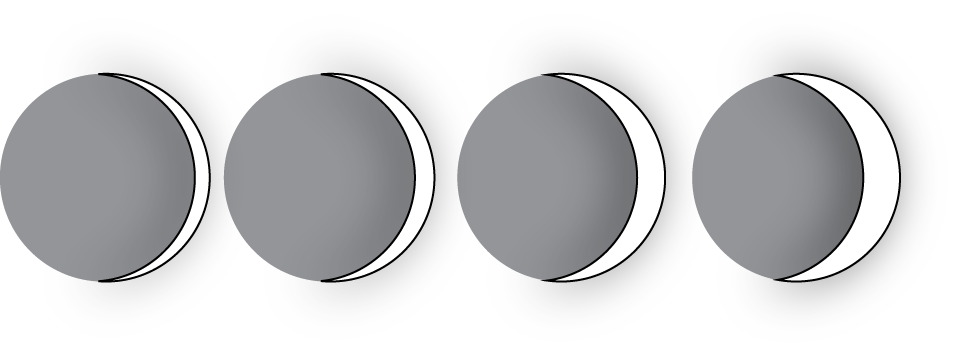
On the first day after the new moon, 2% of the moon's surface is illuminated. On the second day, 6% is illuminated.
-
Based on this information, predict the day on which the moon's surface is 50% illuminated and 100% illuminated.
-
The moon's surface is 100% illuminated on day 14. Does this agree with the prediction you made?
-
Is the percentage illumination of the moon's surface a linear function of the day?
Problem 2
In science class, Jada uses a graduated cylinder with water in it to measure the volume of some marbles. After dropping in 4 marbles so they are all under water, the water in the cylinder is at a height of 10 milliliters. After dropping in 6 marbles so they are all under water, the water in the cylinder is at a height of 11 milliliters.
- What is the volume of 1 marble?
- How much water was in the cylinder before any marbles were dropped in?
- What should be the height of the water after 13 marbles are dropped in?
- Is the volume of water a linear relationship with the number of marbles dropped in the graduated cylinder? If so, what does the slope of the line mean? If not, explain your reasoning.
Problem 3 (from Unit 4, Lesson 5)
Solve each of these equations. Explain or show your reasoning.
Problem 4
For a certain city, the high temperatures (in degrees Celsius) are plotted against the number of days after the new year.
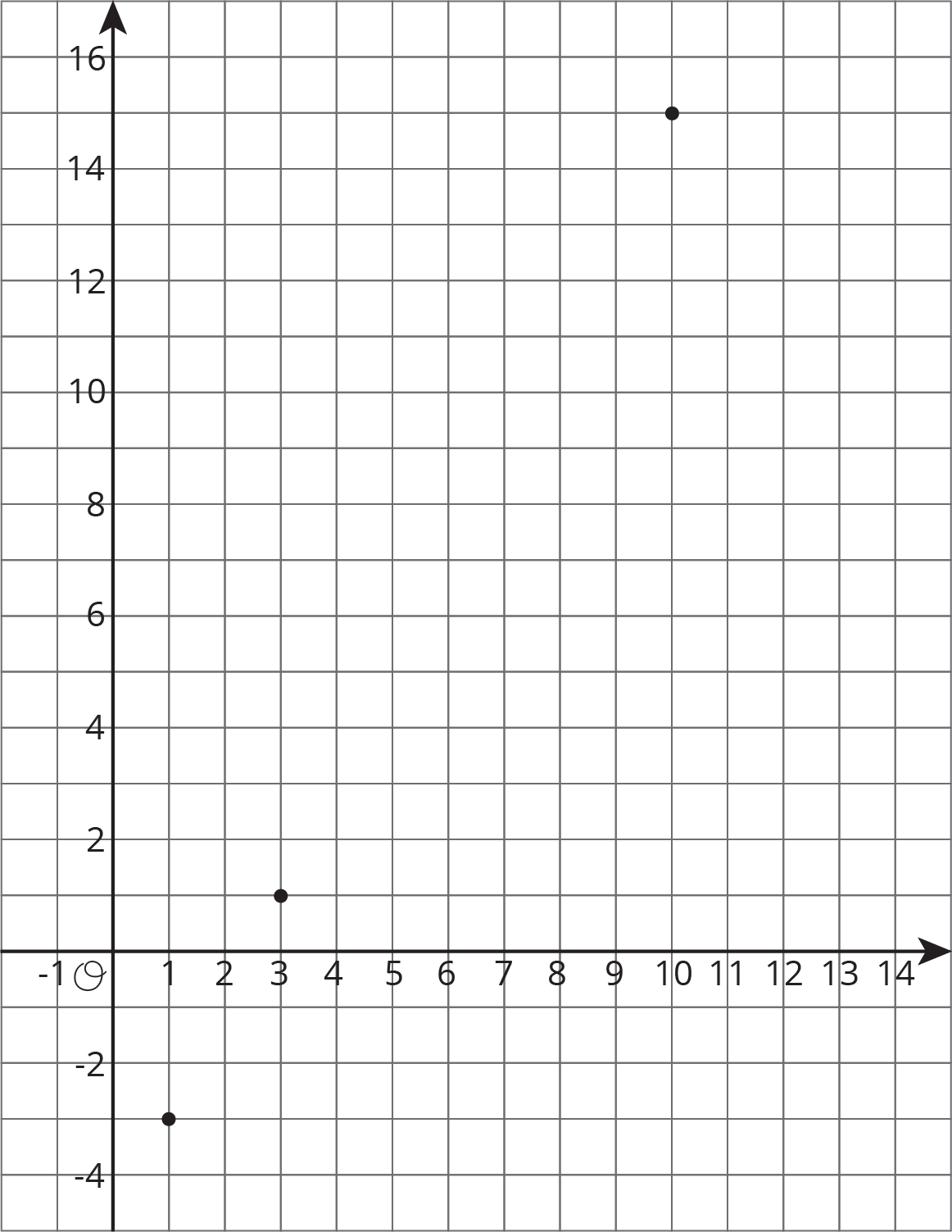 Based on this information, is the high temperature in this city a linear function of the number of days after the new year?
Based on this information, is the high temperature in this city a linear function of the number of days after the new year?
Problem 5 (from Unit 4, Lesson 15)
The school designed their vegetable garden to have a perimeter of 32 feet with the length measuring two feet more than twice the width.
-
Using $\ell$ to represent the length of the garden and $w$ to represent its width, write and solve a system of equations that describes this situation.
-
What are the dimensions of the garden?
Lesson 10
Problem 1
The graph shows the distance of a car from home as a function of time.

Describe what a person watching the car may be seeing.
Problem 2 (from Unit 5, Lesson 7)
The equation and the graph represent two functions. Use the equation $y=4$ and the graph to answer the questions.
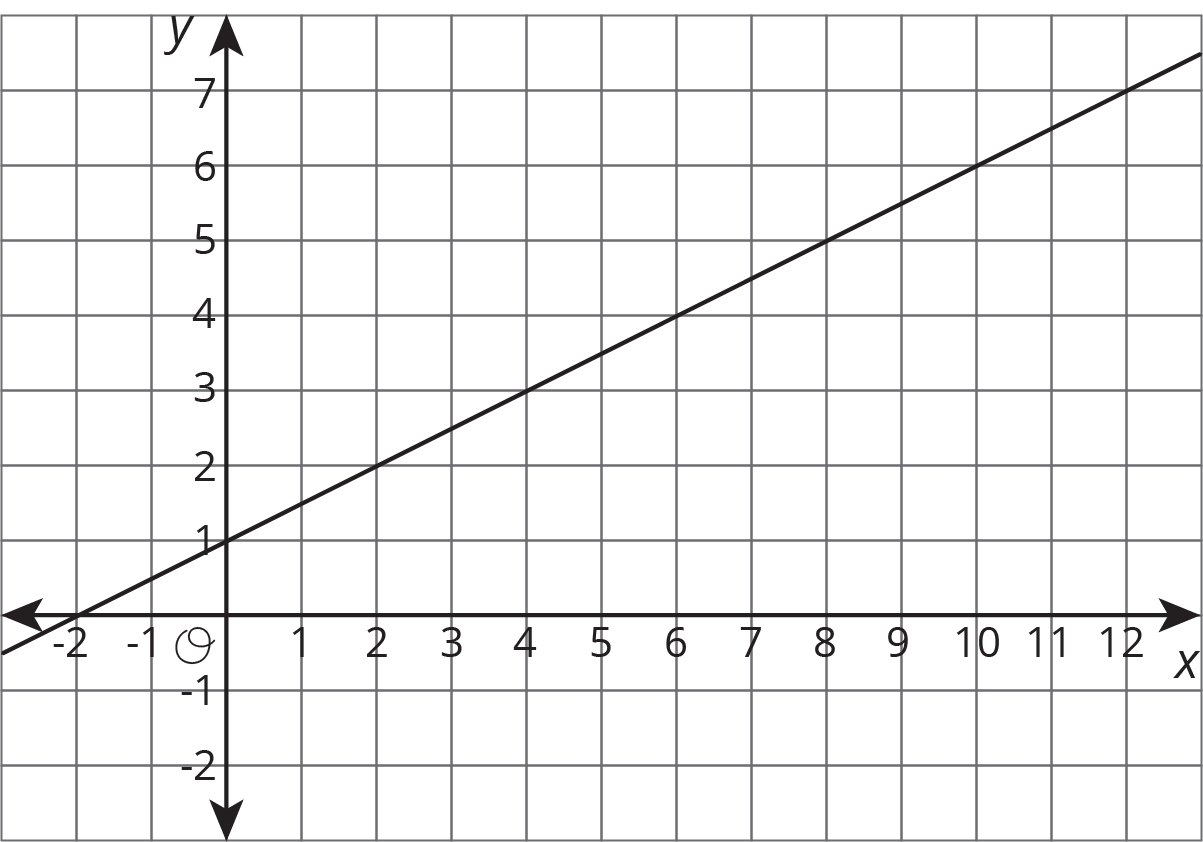
- When $x$ is 4, is the output of the equation or the graph greater?
- What value for $x$ produces the same output in both the graph and the equation?
Problem 3

This graph shows a trip on a bike trail. The trail has markers every 0.5 km showing the distance from the beginning of the trail.
-
When was the bike rider going the fastest?
-
When was the bike rider going the slowest?
-
During what times was the rider going away from the beginning of the trail?
-
During what times was the rider going back towards the beginning of the trail?
-
During what times did the rider stop?
Problem 4 (from Unit 4, Lesson 9)
The expression $\text-25t+1250$ represents the volume of liquid of a container after $t$ seconds. The expression $50t+250$ represents the volume of liquid of another container after $t$ seconds. What does the equation $\text-25t+1250=50t+250$ mean in this situation?
Lesson 11
Problem 1
Cylinder A, B, and C have the same radius but different heights. Put the cylinders in order of their volume from least to greatest.

Problem 2
Two cylinders, $a$ and $b$, each started with different amounts of water. The graph shows how the height of the water changed as the volume of water increased in each cylinder. Match the graphs of $a$ and $b$ to Cylinders P and Q. Explain your reasoning.
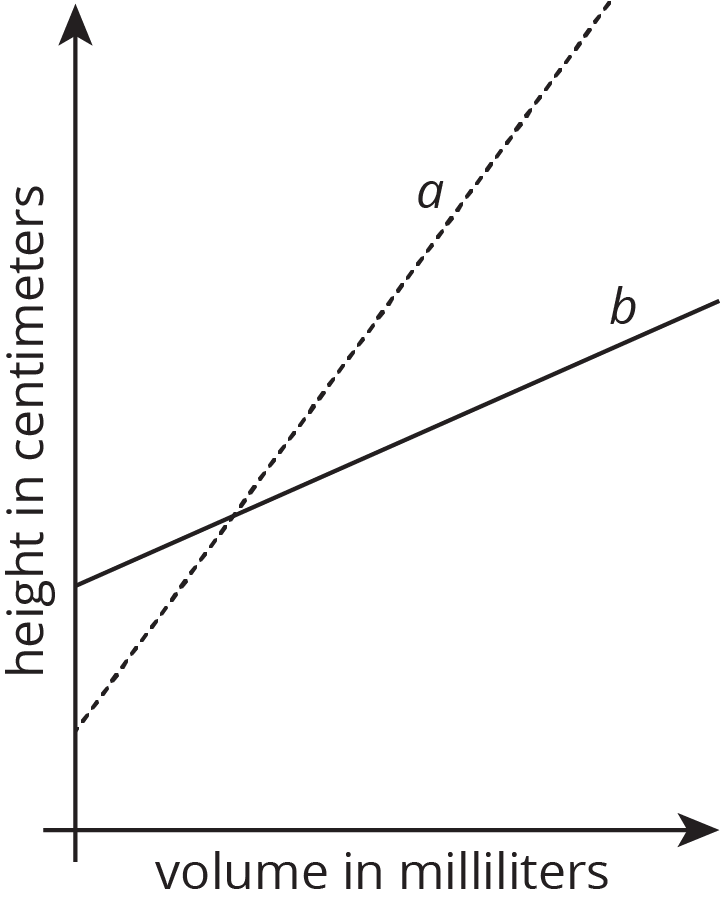
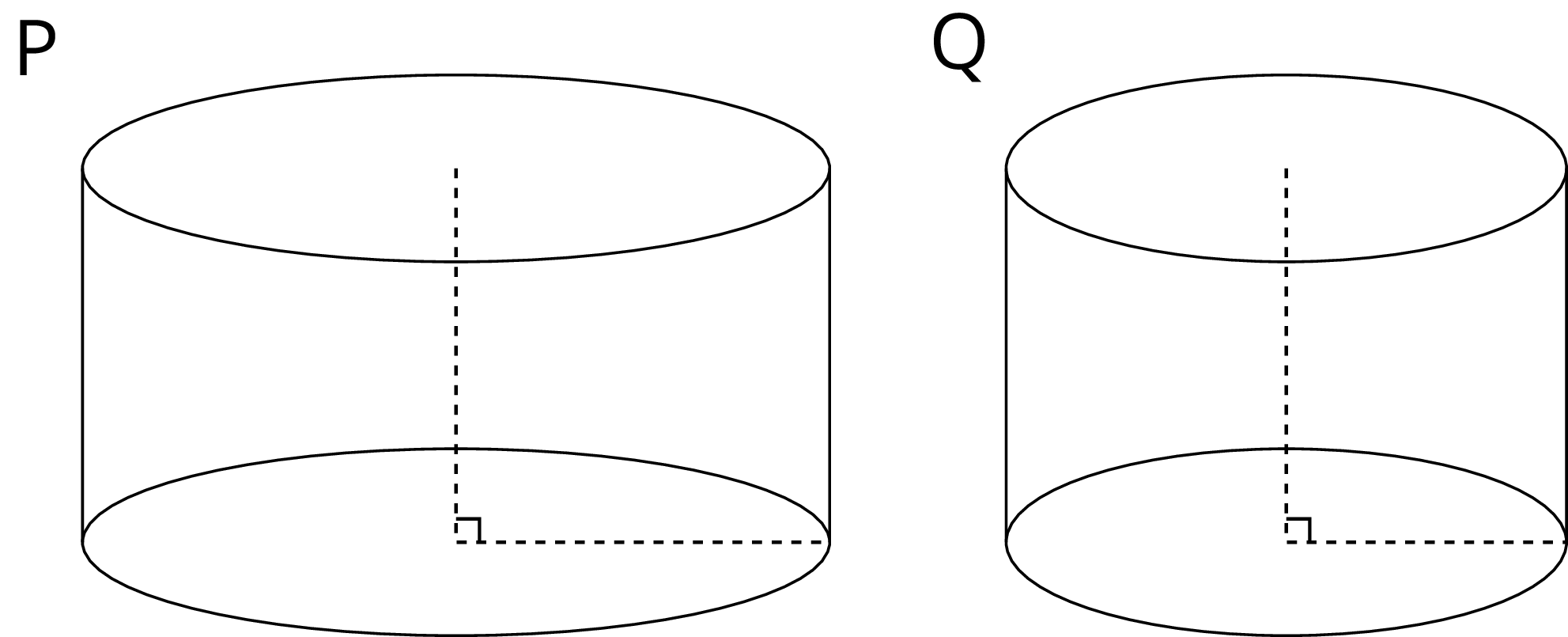
Problem 3
Which of the following graphs could represent the volume of water in a cylinder as a function of its height? Explain your reasoning.

Problem 4 (from Unit 5, Lesson 3)
Together, the areas of the rectangles sum to 30 square centimeters.

- Write an equation showing the relationship between $x$ and $y$.
- Fill in the table with the missing values.
$x$ 3 8 12 $y$ 5 10
Lesson 12
Problem 1
- Sketch a cube and label its side length as 4 cm (this will be Cube A).
- Sketch a cube with sides that are twice as long as Cube A and label its side length (this will be Cube B).
- Find the volumes of Cube A and Cube B.
Problem 2
Several glass aquariums of various sizes are for sale at a pet shop. They are all shaped like rectangular prisms. A 15-gallon tank is 24 inches long, 12 inches wide, and 12 inches tall. Match the dimensions of the other tanks with the volume of water they can each hold.
- Tank 1: 36 inches long, 18 inches wide, and 12 inches tall
- Tank 2: 16 inches long, 8 inches wide, and 10 inches tall
- Tank 3: 30 inches long, 12 inches wide, and 12 inches tall
- Tank 4: 20 inches long, 10 inches wide, and 12 inches tall
- 5 gallons
- 10 gallons
- 20 gallons
- 30 gallons
Problem 3
Two paper drink cups are shaped like cones. The small cone can hold 6 oz of water. The large cone is $\frac43$ the height and $\frac43$ the diameter of the small cone. Which of these could be the amount of water the large cone holds?
- 8 cm
- 14 oz
- 4.5 oz
- 14 cm
Problem 4 (from Unit 5, Lesson 7)
The graph represents the volume of a cylinder with a height equal to its radius.
- When the diameter is 2, what is the radius of the cylinder?
- Express the volume of a cube of side length $s$ as an equation.
- Make a table for volume of the cube at $s=0$, $s=1$, $s=2$, and $s=3$.
- Which volume is greater: the volume of the cube when $s=3$, or the volume of the cylinder when its diameter is 3?

Problem 5 (from Unit 3, Lesson 10)
Select all the points that are on a line with slope 2 that also contains the point $(2, \text-1)$.
- $(3,1)$
- $(1,1)$
- $(1,\text-3)$
- $(4,0)$
- $(6,7)$
Problem 6 (from Unit 4, Lesson 14)
Solve: \(\begin{cases} y=\text-2x-20 \\ y=x+4 \\ \end{cases}\)
Lesson 13
Problem 1
Match each set of information about a circle with the area of that circle.
- Circle A has a radius of 4 units.
- Circle B has a radius of 10 units.
- Circle C has a diameter of 16 units.
- Circle D has a circumference of $4\pi$ units.
- $4\pi$ square units
- approximately 314 square units
- $64\pi$ square units
- $16\pi$ square units
Problem 2
- Sketch a cylinder.
- Label its radius 3 and its height 10.
- Shade in one of its bases.
Problem 3
At a farm, animals are fed bales of hay and buckets of grain. Each bale of hay is in the shape a rectangular prism. The base has side lengths 2 feet and 3 feet, and the height is 5 feet. Each bucket of grain is a cylinder with a diameter of 3 feet. The height of the bucket is 5 feet, the same as the height of the bale.
-
Which is larger in area, the rectangular base of the bale or the circular base of the bucket? Explain how you know.
-
Which is larger in volume, the bale or the bucket? Explain how you know.
Problem 4
Three cylinders have a height of 8 cm. Cylinder 1 has a radius of 1 cm. Cylinder 2 has a radius of 2 cm. Cylinder 3 has a radius of 3 cm. Find the volume of each cylinder.
Problem 5 (from Unit 5, Lesson 12)
A one-quart container of tomato soup is shaped like a rectangular prism. A soup bowl shaped like a hemisphere can hold 8 oz of liquid. How many bowls will the soup container fill? Recall that 1 quart is equivalent to 32 fluid ounces (oz).
Problem 6 (from Unit 5, Lesson 8)
Two students join a puzzle solving club and get faster at finishing the puzzles as they get more practice. Student A improves their times faster than Student B.

- Match the students to the Lines $\ell$ and $m$.
- Which student was faster at puzzle solving before practice?
Lesson 14
Problem 1
Complete the table with all of the missing information about three different cylinders.
| diameter of base (units) | area of base (square units) | height (units) | volume (cubic units) | |
|---|---|---|---|---|
| row 1 | 4 | 10 | ||
| row 2 | 6 | $63 \pi$ | ||
| row 3 | $25 \pi$ | 6 |
Problem 2
A cylinder has volume $45\pi$ and radius 3. What is its height?
Problem 3
Three cylinders have a volume of 2826 cm3. Cylinder A has a height of 900 cm. Cylinder B has a height of 225 cm. Cylinder C has a height of 100 cm. Find the radius of each cylinder. Use 3.14 as an approximation for $\pi$.
Problem 4 (from Unit 5, Lesson 13)
A gas company's delivery truck has a cylindrical tank that is 14 feet in diameter and 40 feet long.
-
Sketch the tank, and mark the radius and the height.
-
How much gas can fit in the tank?
Problem 5 (from Unit 5, Lesson 5)
Here is a graph that shows the water height of the ocean between September 22 and September 24, 2016 in Bodega Bay, CA.
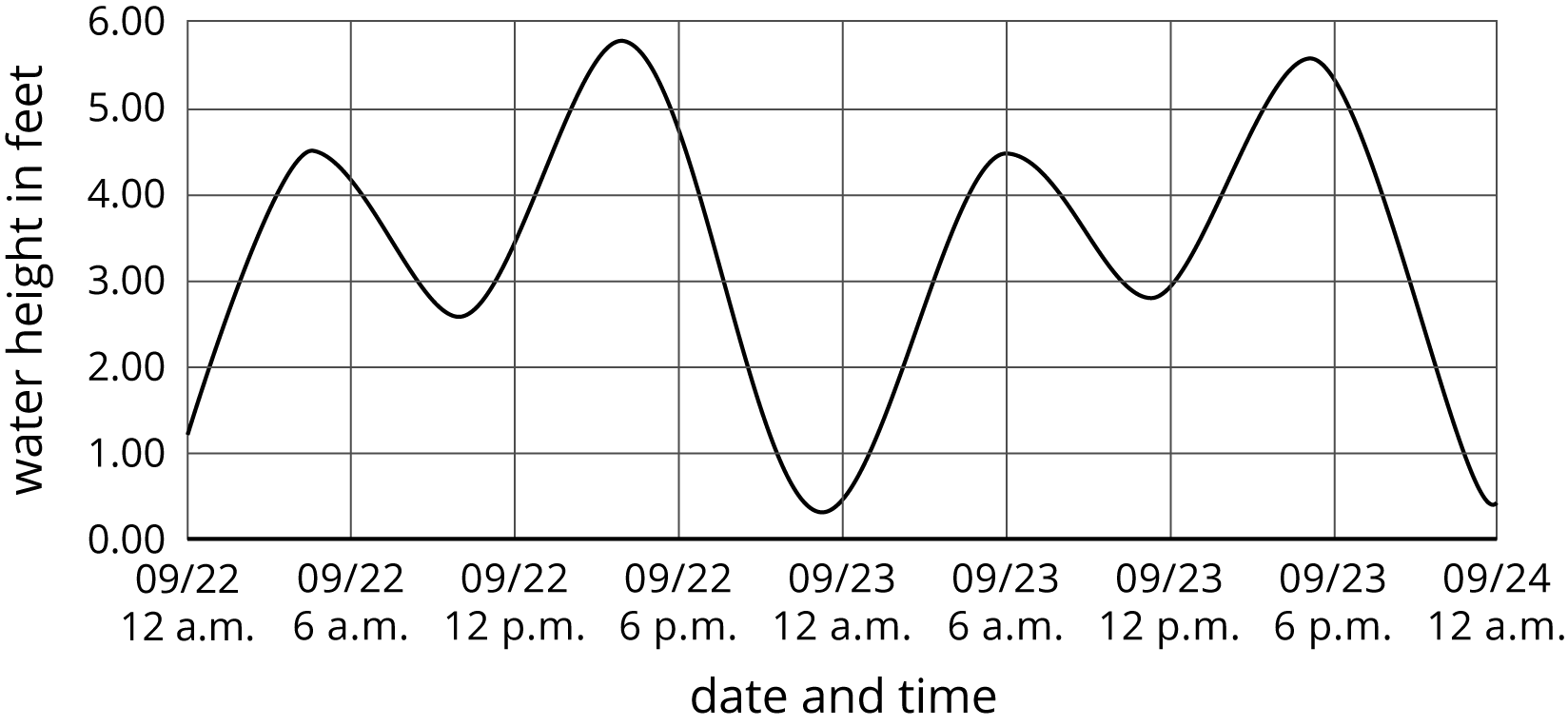
-
Estimate the water height at 12 p.m. on September 22.
-
How many times was the water height 5 feet? Find two times when this happens.
-
What was the lowest the water got during this time period? When does this occur?
-
Does the water ever reach a height of 6 feet?
Lesson 15
Problem 1
A cylinder and cone have the same height and radius. The height of each is 5 cm, and the radius is 2 cm. Calculate the volume of the cylinder and the cone.
Problem 2
The volume of this cone is $36\pi$ cubic units.

What is the volume of a cylinder that has the same base area and the same height?
Problem 3 (from Unit 5, Lesson 14)
A cylinder has a diameter of 6 cm and a volume of $36\pi$ cm3.
- Sketch the cylinder.
- Find its height and radius in centimeters.
- Label your sketch with the cylinder's height and radius.
Problem 4 (from Unit 5, Lesson 10)
Lin wants to get some custom T-shirts printed for her basketball team. Shirts cost \$10 each if you order 10 or fewer shirts and \$9 each if you order 11 or more shirts.
-
Make a graph that shows the total cost of buying shirts, for 0 through 15 shirts.
-
There are 10 people on the team. Do they save money if they buy an extra shirt? Explain your reasoning.
-
What is the slope of the graph between 0 and 10? What does it mean in the story?
-
What is the slope of the graph between 11 and 15? What does it mean in the story?
Problem 5 (from Unit 5, Lesson 6)
In the following graphs, the horizontal axis represents time and the vertical axis represents distance from school. Write a possible story for each graph.

Lesson 16
Problem 1 (from Unit 5, Lesson 15)
The volume of this cylinder is $175\pi$ cubic units.

What is the volume of a cone that has the same base area and the same height?
Problem 2
A cone has volume $12\pi$ cubic inches. Its height is 4 inches. What is its radius?
Problem 3
A cone has volume $3 \pi$.
-
If the cone's radius is 1, what is its height?
-
If the cone's radius is 2, what is its height?
-
If the cone's radius is 5, what is its height?
-
If the cone's radius is $\frac 1 2$, what is its height?
-
If the cone's radius in $r$, then what is the height?
Problem 4 (from Unit 5, Lesson 6)
Three people are playing near the water. Person A stands on the dock. Person B starts at the top of a pole and ziplines into the water. Person C climbs out of the water and up the zipline pole. Match the people to the graphs where the horizontal axis represents time in seconds and the vertical axis represents height above the water level in feet.

Problem 5 (from Unit 5, Lesson 3)
A room is 15 feet tall. An architect wants to include a window that is 6 feet tall. The distance between the floor and the bottom of the window is $b$ feet. The distance between the ceiling and the top of the window is $a$ feet. This relationship can be described by the equation $$a = 15 - (b + 6)$$
- Which variable is independent based on the equation given?
- If the architect wants $b$ to be 3, what does this mean? What value of $a$ would work with the given value for $b$?
- The customer wants the window to have 5 feet of space above it. Is the customer describing $a$ or $b$? What is the value of the other variable?
Lesson 17
Problem 1
A cylinder has a volume of $48 \pi$ cm3 and height $h$. Complete this table for volume of cylinders with the same radius but different heights.
| height (cm) | volume (cm3) | |
|---|---|---|
| row 1 | $h$ | $48\pi$ |
| row 2 | $2h$ | |
| row 3 | $5h$ | |
| row 4 | $\frac h2$ | |
| row 5 | $\frac h5$ |
Problem 2
A cylinder has a radius of 3 cm and a height of 5 cm.
- What is the volume of the cylinder?
- What is the volume of the cylinder when its height is tripled?
- What is the volume of the cylinder when its height is halved?
Problem 3
A graduated cylinder that is 24 cm tall can hold 1 L of water. What is the radius of the cylinder? What is the height of the 500 ml mark? The 250 ml mark? Recall that 1 liter (L) is equal to 1000 milliliters (ml).
Problem 4 (from Unit 5, Lesson 16)
An ice cream shop offers two ice cream cones. The waffle cone holds 12 ounces and is 5 inches tall. The sugar cone also holds 12 ounces and is 8 inches tall. Which cone has a larger radius?
Problem 5 (from Unit 5, Lesson 15)
A 6 oz paper cup is shaped like a cone with a diameter of 4 inches. How many ounces of water will a plastic cylindrical cup with a diameter of 4 inches hold if it is the same height as the paper cup?
Problem 6 (from Unit 5, Lesson 9)
Lin's smart phone was fully charged when she started school at 8:00 a.m. At 9:20 a.m., it was 90% charged, and at noon, it was 72% charged.
-
When do you think her battery will die?
-
Is battery life a function of time? If yes, is it a linear function? Explain your reasoning.
Lesson 18
Problem 1
There are many cylinders with a height of 18 meters. Let $r$ represent the radius in meters and $V$ represent the volume in cubic meters.
-
Write an equation that represents the volume $V$ as a function of the radius $r$.
-
Complete this table, giving three possible examples.
$r$ $V$ row 1 1 row 2 row 3 -
If the radius of a cylinder is doubled, does the volume double? Explain how you know.
-
Is the graph of this function a line? Explain how you know.
Problem 2 (from Unit 5, Lesson 3)
As part of a competition, Diego must spin around in a circle 6 times and then run to a tree. The time he spends on each spin is represented by $s$ and the time he spends running is $r$. He gets to the tree 21 seconds after he starts spinning.
- Write an equation showing the relationship between $s$ and $r$.
- Rearrange the equation so that it shows $r$ as a function of $s$.
- If it takes Diego 1.2 seconds to spin around each time, how many seconds did he spend running?
Problem 3 (from Unit 5, Lesson 7)
The table and graph represent two functions. Use the table and graph to answer the questions.
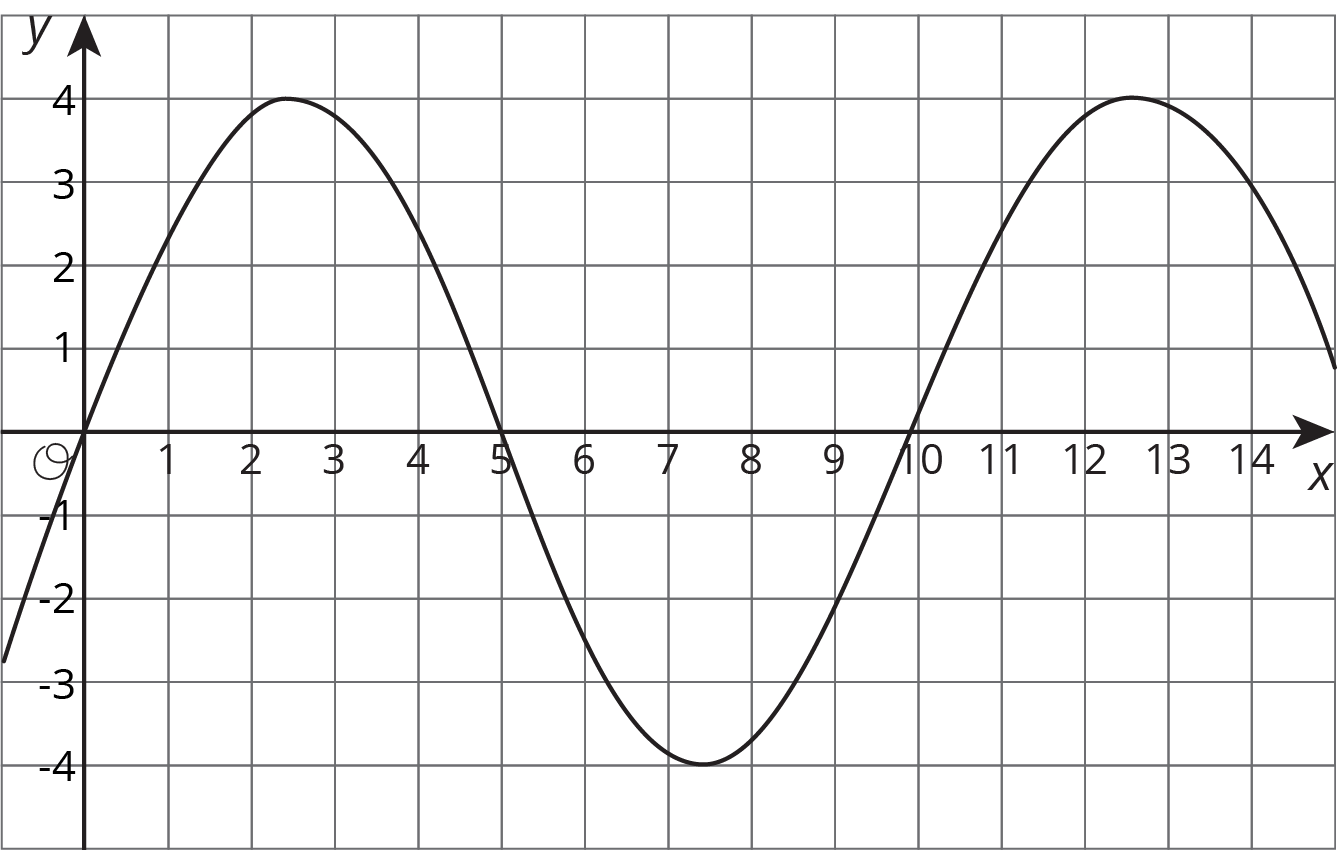
| $x$ | 1 | 2 | 3 | 4 | 5 | 6 |
|---|---|---|---|---|---|---|
| $y$ | 3 | -1 | 0 | 4 | 5 | -1 |
- For which values of $x$ is the output from the table less than the output from the graph?
- In the graphed function, which values of $x$ give an output of 0?
Problem 4
A cone has a radius of 3 units and a height of 4 units.
-
What is this volume of this cone?
-
Another cone has quadruple the radius, and the same height. How many times larger is the new cone's volume?
Lesson 19
Problem 1
A baseball fits snugly inside a transparent display cube. The length of an edge of the cube is 2.9 inches.
Is the baseball's volume greater than, less than, or equal to $2.9^3$ cubic inches? Explain how you know.
Problem 2 (from Unit 5, Lesson 18)
There are many possible cones with a height of 18 meters. Let $r$ represent the radius in meters and $V$ represent the volume in cubic meters.
-
Write an equation that represents the volume $V$ as a function of the radius $r$.
-
Complete this table for the function, giving three possible examples.
$r$ $V$ row 1 2 row 2 row 3 -
If you double the radius of a cone, does the volume double? Explain how you know.
-
Is the graph of this function a line? Explain how you know.
Problem 3
A hemisphere fits snugly inside a cylinder with a radius of 6 cm. A cone fits snugly inside the same hemisphere.
- What is the volume of the cylinder?
- What is the volume of the cone?
- Estimate the volume of the hemisphere by calculating the average of the volumes of the cylinder and cone.
Problem 4
-
Find the hemisphere's diameter if its radius is 6 cm.
-
Find the hemisphere's diameter if its radius is $\frac{1000}{3}$ m.
-
Find the hemisphere's diameter if its radius is 9.008 ft.
-
Find the hemisphere's radius if its diameter is 6 cm.
-
Find the hemisphere's radius if its diameter is $\frac{1000}{3}$ m.
-
Find the hemisphere's radius if its diameter is 9.008 ft.
Problem 5 (from Unit 5, Lesson 9)
After almost running out of space on her phone, Elena checks with a couple of friends who have the same phone to see how many pictures they have on their phones and how much memory they take up. The results are shown in the table.
| number of photos | 2,523 | 3,148 | 1,875 |
|---|---|---|---|
| memory used in MB | 8,072 | 10,106 | 6,037 |
- Could this information be reasonably modeled with a linear function? Explain your reasoning.
- Elena needs to delete photos to create 1,200 MB of space. Estimate the number of photos should she delete.
Lesson 20
Problem 1
Match the description of each sphere to its correct volume.
- Sphere A: radius of 4 cm
- Sphere B: diameter of 6 cm
- Sphere C: radius of 8 cm
- Sphere D: radius of 6 cm
- $288\pi$ cm3
- $\frac{256}3 \pi$ cm3
- $36\pi$ cm3
- $\frac {2048}3 \pi$ cm3
Problem 2
-
A cube's volume is 512 cubic units. What is the length of its edge?
-
If a sphere fits snugly inside this cube, what is its volume?
-
What fraction of the cube is taken up by the sphere? What percentage is this? Explain or show your reasoning.
Problem 3
Sphere A has radius 2 cm. Sphere B has radius 4 cm.
- Calculate the volume of each sphere.
- The radius of Sphere B is double that of Sphere A. How many times greater is the volume of B?
Problem 4 (from Unit 5, Lesson 16)
Three cones have a volume of $192\pi$ cm3. Cone A has a radius of 2 cm. Cone B has a radius of 3 cm. Cone C has a radius of 4 cm. Find the height of each cone.
Problem 5 (from Unit 5, Lesson 5)
The graph represents the average price of regular gasoline in the United States in dollars as a function of the number of months after January 2014.
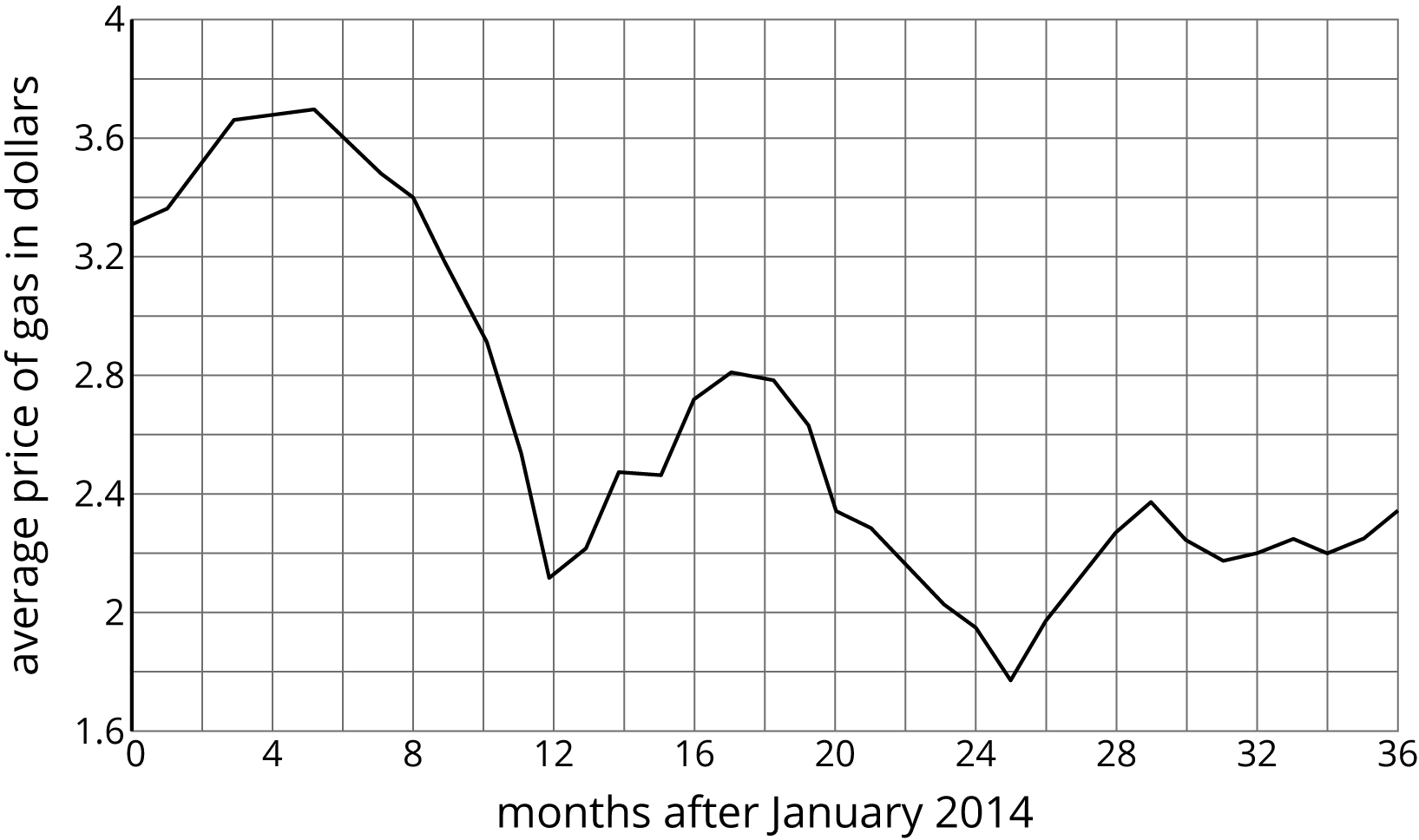
- How many months after January 2014 was the price of gas the greatest?
- Did the average price of gas ever get below \$2?
- Describe what happened to the average price of gas in 2014.
Problem 6 (from Unit 4, Lesson 15)
While conducting an inventory in their bicycle shop, the owner noticed the number of bicycles is 2 fewer than 10 times the number of tricycles. They also know there are 410 wheels on all the bicycles and tricycles in the store. Write and solve a system of equations to find the number of bicycles in the store.
Lesson 21
Problem 1
A scoop of ice cream has a 3 inch radius. How tall should the ice cream cone of the same radius be in order to contain all of the ice cream inside the cone?
Problem 2
Calculate the volume of the following shapes with the given information. For the first three questions, give each answer both in terms of $\pi$ and by using $3.14$ to approximate $\pi$. Make sure to include units.
-
Sphere with a diameter of 6 inches
-
Cylinder with a height of 6 inches and a diameter of 6 inches
-
Cone with a height of 6 inches and a radius of 3 inches
-
How are these three volumes related?
Problem 3
A coin-operated bouncy ball dispenser has a large glass sphere that holds many spherical balls. The large glass sphere has a radius of 9 inches. Each bouncy ball has radius of 1 inch and sits inside the dispenser.
If there are 243 bouncy balls in the large glass sphere, what proportion of the large glass sphere's volume is taken up by bouncy balls? Explain how you know.
Problem 4 (from Unit 5, Lesson 13)
A farmer has a water tank for cows in the shape of a cylinder with radius of 7 ft and a height of 3 ft. The tank comes equipped with a sensor to alert the farmer to fill it up when the water falls to 20% capacity. What is the volume of the tank be when the sensor turns on?
Lesson 22
No practice problems for this lesson.
4-5 Practice Writing a Function Rule Answer Key
Source: https://access.openupresources.org/curricula/our6-8math-v1/8/students/5/practice_problems.html
0 Response to "4-5 Practice Writing a Function Rule Answer Key"
Post a Comment